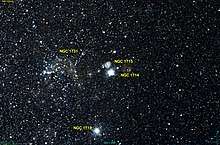NGC 1714
NGC 1714 is an emission nebula in the constellation of Dorado.[1][2] It is located in the Large Magellanic Cloud[3] and was discovered by John Herschel on 2 November 1834.[4] A study investigating the chemical composition of HII regions in the Large Magellanic Cloud was conducted in it, finding a larger deuterium density than previously thought, leading to (with current knowledge) larger than accepted age of the universe.[5] Candidates for planetary nebula have also been found in the vicinity of NGC 1714.[6]
| Emission nebula | |
|---|---|
 | |
| Observation data: J2000 epoch | |
| Right ascension | 04h 52m |
| Declination | ±66° 55′ |
| Apparent magnitude (V) | 11.61 |
| Apparent dimensions (V) | 1.1 arcmin |
| Constellation | Dorado |
References
- Q938880. (2019, February 28). Wikidata. Retrieved 11:38, March 16, 2019 from https://www.wikidata.org/w/index.php?title=Q938880&oldid=869778701.
- "Monochromatic observations of three nebular objects in the direction of NGC 1714". ResearchGate. ResearchGate. Retrieved 16 March 2019.
- Ford, Dominic. "The emission NGC 1714 - In-The-Sky.org". in-the-sky.org. Retrieved 2019-03-15.
- "NGC 1714". simbad. Retrieved 2019-03-15.
- "New General Catalog Objects: NGC 1700 - 1749". cseligman.com. Retrieved 2019-03-19.
- Piembert, Manuel (May 1974). "CHEMICAL COMPOSITION OF HII REGIONS IN THE LARGE MAGELLANIC CLOUD AND ITS COSMOLOGICAL IMPLICATIONS". The Astrophysical Journal. 193. doi:10.1086/153166.
- Louise, R.; Maurice (August 1984). "Monochromatic observations of three nebular objects in the direction of NGC 1714". Astrophysics and Space Science. 103.
This article is issued from Wikipedia. The text is licensed under Creative Commons - Attribution - Sharealike. Additional terms may apply for the media files.